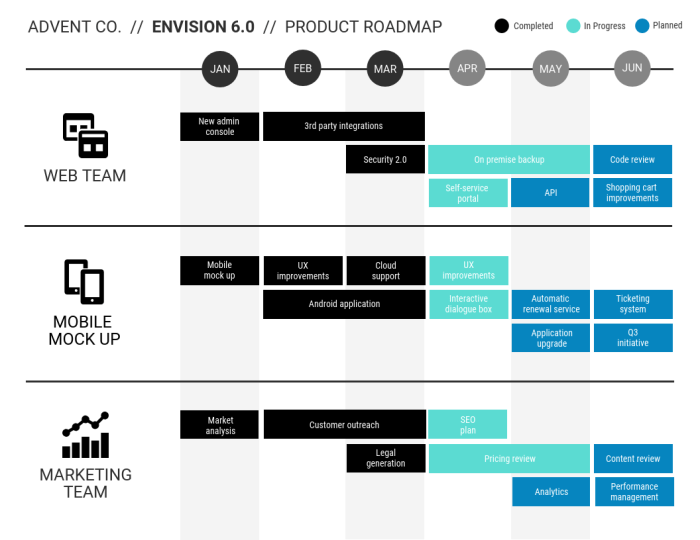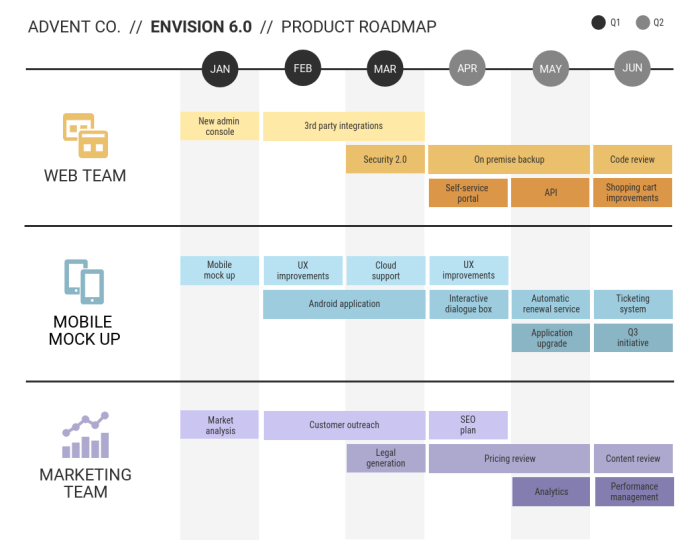Developing a Product Roadmap takes center stage in the business world, offering a strategic blueprint for success. Get ready to dive into the key elements and steps involved in creating an effective roadmap that aligns with your business goals.
Understanding Product Roadmaps

Product roadmap is a strategic document that Artikels the vision, direction, and timeline for a product’s development. It serves as a guiding tool for product managers, developers, and stakeholders to align on priorities and goals throughout the product lifecycle.
Key Elements of a Product Roadmap
- Goals and Objectives: Clearly defined targets and milestones for the product.
- Features and Enhancements: List of functionalities to be developed or improved.
- Timeline: Estimated release dates and project timelines.
- Dependencies: Relationships between different tasks and features.
- Resources: Allocation of team members and resources for each phase.
Examples of Successful Product Roadmaps
- Apple: Known for its product roadmap secrecy, Apple’s releases are highly anticipated and carefully planned.
- Google: Google’s product roadmap for Android updates and new features is transparent and regularly updated for users and developers.
- Tesla: Tesla’s roadmap for electric vehicles includes future models, software updates, and advancements in autonomous driving technology.
Benefits of a Well-Defined Product Roadmap
- Alignment: Ensures everyone is on the same page regarding product goals and priorities.
- Transparency: Provides clarity on the product development process for stakeholders and customers.
- Risk Mitigation: Helps identify potential risks and challenges early on to address proactively.
- Efficiency: Streamlines the development process by focusing on key deliverables and deadlines.
Creating a Product Roadmap: Developing A Product Roadmap
Creating a product roadmap is essential for guiding the development and evolution of a product. It involves outlining the vision, goals, and timeline for the product’s features and enhancements.
Steps Involved in Creating an Effective Product Roadmap
- Define the product vision and goals: Clearly Artikel what the product aims to achieve and the key objectives it needs to fulfill.
- Identify target market and user needs: Understand the target audience and their requirements to prioritize features effectively.
- Map out feature priorities: List all potential features and enhancements, then prioritize them based on impact and feasibility.
- Set a timeline and milestones: Establish a timeline for feature releases and set milestones to track progress.
Prioritizing Features and Enhancements
- Use a prioritization framework: Implement frameworks like MoSCoW (Must have, Should have, Could have, Won’t have) to prioritize features based on importance.
- Consider user feedback: Gather feedback from users to understand their preferences and prioritize features that align with their needs.
- Focus on value: Prioritize features that deliver the most value to users and align with the product vision.
Aligning the Product Roadmap with Business Strategy
- Understand business objectives: Ensure the product roadmap aligns with the overall business goals and strategy.
- Collaborate with stakeholders: Involve key stakeholders in the process to ensure alignment between the product roadmap and business strategy.
- Regularly review and adjust: Continuously review the product roadmap to ensure it remains aligned with evolving business needs.
Importance of Stakeholder Involvement
- Gain diverse perspectives: Stakeholders bring different insights and priorities to the table, helping create a well-rounded product roadmap.
- Build buy-in and support: Involving stakeholders early fosters buy-in and support for the product roadmap, increasing the likelihood of successful implementation.
- Ensure alignment with business goals: Stakeholders help ensure that the product roadmap reflects the broader business objectives and priorities.
Iterative Development and Adaptation

Product roadmaps are not set in stone but evolve over time through iterative development. This process involves continuous refinement and adjustments to align with changing market dynamics and customer needs.
Adapting to Market Changes
Adapting a product roadmap in response to market changes requires a deep understanding of the evolving landscape. This involves gathering feedback from customers, analyzing market trends, and staying abreast of competitors’ movements.
- Utilizing customer feedback to identify areas for improvement and new opportunities.
- Monitoring market trends and adjusting the roadmap to capitalize on emerging opportunities.
- Responding quickly to competitor actions by tweaking the roadmap to maintain a competitive edge.
Role of Feedback and Data Analysis
Feedback and data analysis play a crucial role in refining a product roadmap. They provide valuable insights into customer preferences, market trends, and product performance, helping to prioritize features and enhancements.
By analyzing user data and feedback, companies can make informed decisions about which features to prioritize and which to deprioritize.
Successful Adaptation Examples
Dynamic industries have witnessed successful adaptation of product roadmaps to stay ahead of the curve. Companies that have effectively adjusted their roadmaps include:
- Netflix, which shifted its focus from DVD rentals to streaming services based on changing consumer behavior.
- Apple, which continuously updates its product roadmap based on technological advancements and market trends.
- Tesla, which regularly modifies its roadmap to incorporate new innovations in electric vehicles and autonomous driving technology.
Communicating the Product Roadmap
Effective communication of the product roadmap is crucial for ensuring alignment and understanding among all stakeholders involved in the product development process. By sharing the roadmap clearly and transparently, internal teams, external stakeholders, and customers can stay informed and engaged throughout the product lifecycle.
Internal Communication Strategies, Developing a Product Roadmap
- Hold regular meetings with cross-functional teams to discuss progress and updates on the product roadmap.
- Utilize project management tools such as Jira or Trello to track tasks and milestones, providing visibility to all team members.
- Create detailed documentation outlining the roadmap goals, timelines, and priorities to ensure everyone is on the same page.
- Encourage open communication channels to address any questions or concerns that may arise during the development process.
External Communication Strategies
- Host webinars or virtual events to share the product roadmap with external stakeholders, such as investors or partners.
- Utilize marketing channels, such as social media or newsletters, to update customers on upcoming product releases and features.
- Provide a public-facing roadmap on your company website to showcase your commitment to transparency and customer feedback.
- Engage with customers through surveys or feedback sessions to gather input on the roadmap and make necessary adjustments.
Enhancing Success through Transparency
- Transparency in communication builds trust and credibility with both internal and external audiences, fostering a collaborative environment.
- By involving stakeholders in the product development process, you can gather valuable insights and feedback to refine the roadmap and meet customer needs.
- Clear and consistent communication helps prevent misunderstandings or misalignment, ensuring everyone is working towards the same goals.
- Feedback loops and regular updates keep stakeholders engaged and informed, reducing the risk of surprises or delays in the product roadmap.
Visualization and Sharing Tools
- Use product management platforms like Aha! or Productboard to create interactive and visually appealing roadmaps that can be easily shared with stakeholders.
- Utilize Gantt charts or Kanban boards to visualize timelines and project dependencies, making it easier for teams to track progress and prioritize tasks.
- Collaboration tools such as Slack or Microsoft Teams can facilitate real-time discussions and updates on the product roadmap, enhancing communication efficiency.
- Customized dashboards or reports can provide a snapshot of key metrics and progress indicators, enabling stakeholders to quickly assess the status of the roadmap.
